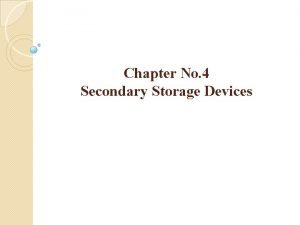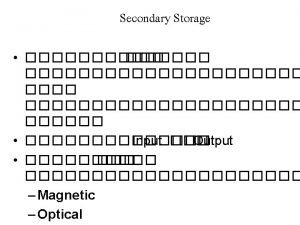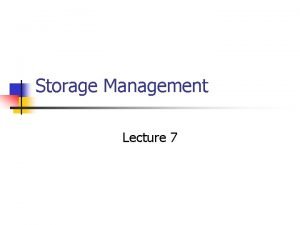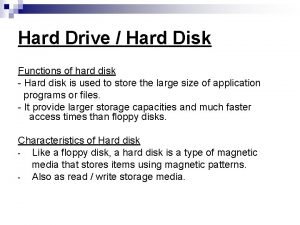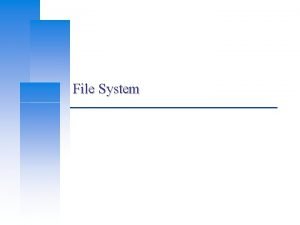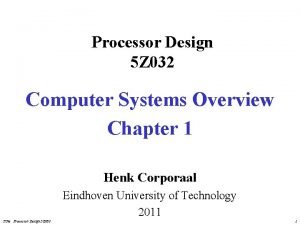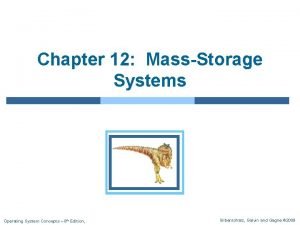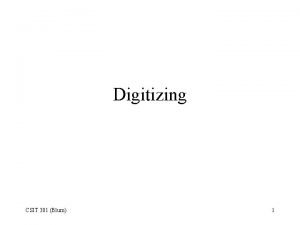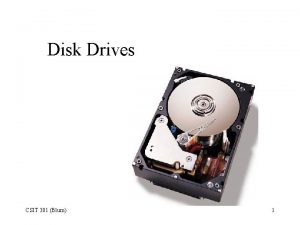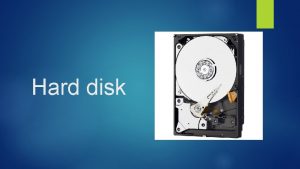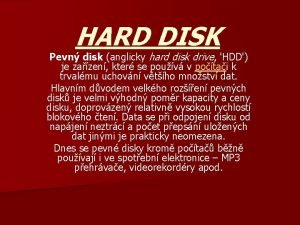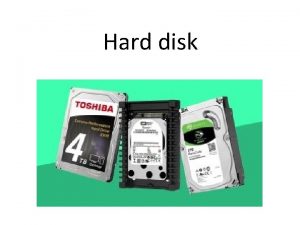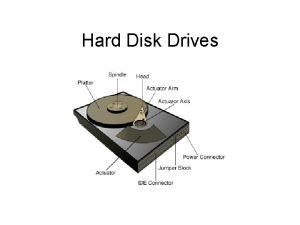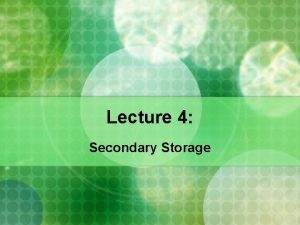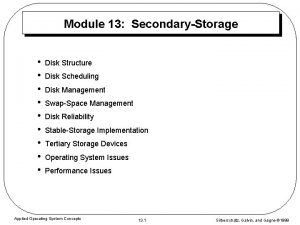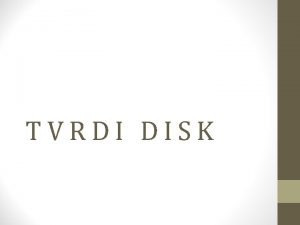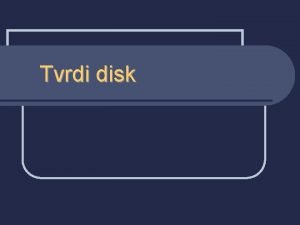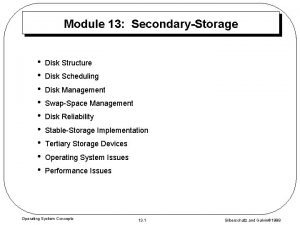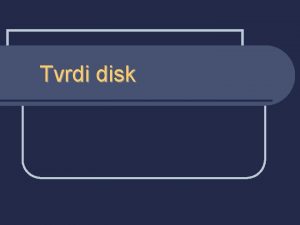Secondary storage Examples of Secondary Storage Hard Disk

















- Slides: 17

Secondary storage

Examples of Secondary Storage:

Hard Disk:

A hard disk is part of a unit, often called a "disk drive, " "hard drive, " or "hard disk drive, " that stores and provides relatively quick access to large amounts of data on an electromagnetically charged surface or set of surfaces. Today's computers typically come with a hard disk that contains several billion bytes (gigabytes) of storage.

Flash Memory:

Flash memory is a type of constantly-powered non volatile memory that can be erased and reprogrammed in units of memory called blocks. It is a variation of electrically erasable programmable read-only memory (EEPROM) which, unlike flash memory, is erased and rewritten at the byte level, which is slower than flash memory updating.

Floppy Disk:

Floppy disks have an interesting name, considering they do not appear to be "floppy. " However, if you take the actual disk out of the protective casing, you will discover that the disk is, in fact, rather flexible. It is coated with iron oxide and stores data magnetically, just like a Hard disk. The first floppy disks were created in 1969, the same year the Internet had its origin. These disks were 8 inches in diameter and were read-only, like a CDROM meaning no data could be written to them by the user. The first 8 inch disks only held 80 KB of data, but later versions could hold as much as 800 KB.

Zip Disk:

An earlier 3. 5" removable disk drive from Iomega. Zip disks came in 100 MB, 250 MB and 750 MB varieties, with the latter introduced in 2002 using USB and Fire. Wire interfaces. The 250 MB drives, introduced in 1998, also read and wrote 100 MB disks. The 750 MB drives read all, but only wrote 250 MB and 750 MB disks. Zip disks were a floppy-like technology that used design concepts from hard disks and Iomega's earlier Bernoulli disks. The drive was bundled with software that could catalog the disks and lock the files for security. When Zip disks were introduced in 1995, they became popular very quickly. Like all removable storage media, the Zip disk was eclipsed by recordable CDs and DVDs and the Internet.

Magnetic tape:

A sequential storage medium used for data collection, backup and archiving. Like videotape, computer tape is made of flexible plastic with one side coated with a ferromagnetic material. Tapes were originally open reels, but were superseded by cartridges and cassettes of many sizes and shapes. Tape has been more economical than disks for archival data, but that is changing as disk capacities have increased enormously. If tapes are stored for the duration, they must be periodically recopied or the tightly coiled magnetic surfaces may contaminate each other.

Punch cards:

An early storage medium made of thin cardboard stock that held data as patterns of punched holes. Also called "punched" cards, each of the 80 or 96 columns held one character. The holes were punched by a keypunch machine or card punch peripheral and were fed into the computer by a card reader. From 1890 until the 1970 s, punch cards were synonymous with data processing. The concepts were simple: the database was the file cabinet; a record was a card. Processing was performed on separate machines called "sorters, " "collators, " "reproducers, " "calculators" and "accounting machines. " Today, the punch card is all but obsolete except for voting systems in some states. The presidential election of 2000 brought punch cards into infamy and made the U. S. the brunt of jokes worldwide for using such antiquated and error-prone systems. The solution in many states was to migrate to electronic voting machines, which happened to be developed without audit trails so that ballots could never be recounted in close elections (see e-voting). So much for

RAM disk:

A disk drive simulated in memory. Also called a "virtual disk" or "emulated disk" (e-disk), selected files are copied from the hard drive to the RAM disk in order to speed up processing. Before the computer is turned off, the data must be saved to the hard drive or other permanent medium. RAM disks for personal computers perform a similar function as large servers in the enterprise that hold huge databases in memory for fast decision support (see in- memory database). RAM disks are also used to capture data that are intentionally not saved. When the computer is

Presented by: Group 2
 Magnetic disk
Magnetic disk Magnetic disk
Magnetic disk Dynamic disk vs basic disk performance
Dynamic disk vs basic disk performance Secondary storage vs primary storage
Secondary storage vs primary storage Storage devices of computer
Storage devices of computer Secondary storage provides temporary or volatile storage
Secondary storage provides temporary or volatile storage Funktion einer festplatte
Funktion einer festplatte Computer hard disk
Computer hard disk Nkb032 hard disk drive
Nkb032 hard disk drive Fixed hard disk
Fixed hard disk Portable hard disk
Portable hard disk Hard disk 1 (301)
Hard disk 1 (301) Principios de la oxigenoterapia
Principios de la oxigenoterapia Windows xp virtual machine download
Windows xp virtual machine download Hard disk 301
Hard disk 301 What is a disk seek
What is a disk seek What makes water hard
What makes water hard Work hard. have fun. make history
Work hard. have fun. make history
